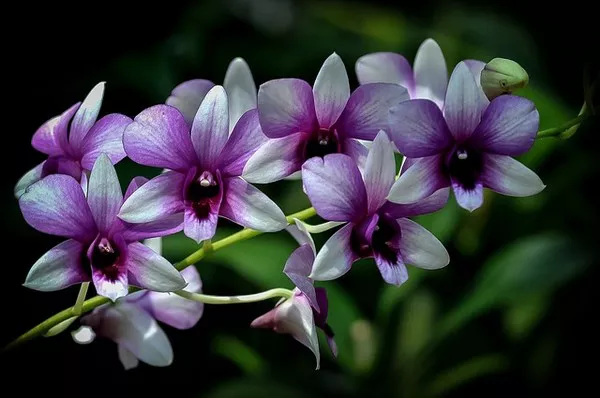In the vast tapestry of the Earth’s flora, some flowers stand out as elusive and exceedingly rare treasures. These botanical wonders, often hidden in remote corners of the world, captivate both botanists and nature enthusiasts alike. While beauty is subjective, the rarity of a flower can make it particularly appealing. In this article, we will delve into the realm of the rarest flowers, shedding light on their uniqueness, the factors contributing to their scarcity, and the ongoing efforts to conserve these floral gems.
The Enigmatic Ghost Orchid (Dendrophylax lindenii)
Our journey to uncover the world’s rarest flowers begins with the ghost orchid, Dendrophylax lindenii, a true botanical enigma. This ethereal orchid, found primarily in the swamps and wetlands of Florida and Cuba, is renowned for its elusive nature and delicate beauty. The ghost orchid’s name aptly captures its ephemeral presence, as it often seems to materialize and vanish mysteriously in the wilderness.
The ghost orchid’s rarity can be attributed to its specialized habitat requirements. It thrives in nutrient-poor environments where water levels fluctuate, and its root system clings to the bark of cypress and pond apple trees. Due to its dependence on specific conditions, the ghost orchid is vulnerable to habitat destruction and climate change, further exacerbating its scarcity.
Conservation efforts have been underway to protect the ghost orchid. These include habitat restoration, controlled propagation, and the enforcement of legal safeguards. Researchers and conservationists continue to study this elusive flower to gain a better understanding of its life cycle and ecological needs, with the hope of ensuring its survival for future generations.
The Ephemeral Corpse Flower (Amorphophallus titanum)
Amorphophallus titanum, commonly known as the corpse flower, is another legendary inhabitant of the botanical world. This enormous and peculiar plant hails from the rainforests of Sumatra, Indonesia. What sets this flower apart is not just its extraordinary size but also its rare and infrequent blooming.
The corpse flower is a prodigious spectacle, with a massive bloom that can reach up to 10 feet in height. Its peculiar name arises from the strong odor it emits during flowering, akin to the stench of a rotting corpse, which serves to attract pollinators. This extraordinary event is a rare occurrence, with some specimens taking years or even decades to bloom, making it a true botanical event that draws crowds of eager spectators.
One of the primary reasons for the corpse flower’s rarity is its complex reproductive biology. It relies on a specific set of environmental conditions to trigger blooming, and these conditions are not often met in the wild. Additionally, deforestation and habitat destruction in Sumatra have further imperiled this species.
In an attempt to conserve the corpse flower, botanical gardens worldwide cultivate these plants, meticulously simulating the necessary conditions for blooming. When a corpse flower blooms in captivity, it often becomes a major attraction, drawing visitors and raising awareness about the importance of preserving its natural habitat.
The Elusive Middlemist’s Red (Middlemist’s Red)
Middlemist’s Red, scientifically known as Middlemist’s Red Camellia, is a flower that exudes elegance and refinement. Native to China, it was brought to England in the early 19th century. Today, it is considered one of the rarest flowers on the planet, with only two known living specimens.
The scarcity of Middlemist’s Red can be attributed to a combination of factors, including its limited natural habitat and historical factors like over-collection. The plant thrives in subtropical climates and was initially cultivated by British horticultural enthusiasts in glasshouses. Unfortunately, the ravages of time, wars, and neglect led to the demise of many specimens, leaving only two known survivors.
Efforts to propagate Middlemist’s Red continue through careful cultivation, and attempts have been made to reintroduce it to its native habitat. Its rarity underscores the importance of preserving both the plant and its natural environment.
The Exquisite Jade Vine (Strongylodon macrobotrys)
From the tropical rainforests of the Philippines, we encounter the mesmerizing Jade Vine, also known as Strongylodon macrobotrys. This striking flower is characterized by its remarkable turquoise or jade-green coloration and cascading clusters of blossoms.
The rarity of the Jade Vine can be attributed to its specific pollination requirements. It relies on bats and moths for pollination, and its unique coloration and scent attract these nocturnal creatures. Habitat destruction and deforestation in the Philippines have significantly diminished the population of its pollinators, putting the Jade Vine at risk.
Conservationists and botanical gardens have undertaken efforts to protect this precious vine by cultivating it in controlled environments and promoting the preservation of its native habitat. These initiatives aim to ensure the survival of this rare and captivating flower for future generations to admire.
The Enigmatic Underground Orchid (Rhizanthella gardneri)
Rhizanthella gardneri, commonly known as the underground orchid, takes rarity to a whole new level. This orchid’s unique adaptation allows it to thrive entirely underground, making it almost impossible to spot in its natural habitat.
This remarkable orchid has no leaves or chlorophyll and obtains its nutrients from mycorrhizal fungi, forming a symbiotic relationship with them. The underground orchid is endemic to Western Australia and is exceedingly rare due to its cryptic nature and specialized ecological niche.
Efforts to conserve the underground orchid focus on understanding its complex biology and preserving the habitats where it is found. Conservationists and researchers work diligently to protect this mysterious flower and its delicate underground existence.
Conclusion
The world’s rarest flowers, like the ghost orchid, corpse flower, Middlemist’s Red, Jade Vine, and underground orchid, captivate us not only with their beauty but also with their incredible scarcity and unique adaptations. These botanical treasures face various challenges, from habitat destruction to climate change, which threaten their survival.
The concerted efforts of botanists, conservationists, and botanical gardens worldwide play a crucial role in preserving these rare flowers. Through controlled propagation, habitat restoration, and public awareness, we can hope to ensure that future generations can continue to marvel at the beauty of these botanical wonders and appreciate the importance of biodiversity conservation.


